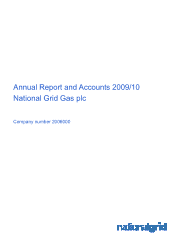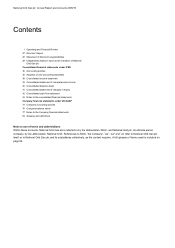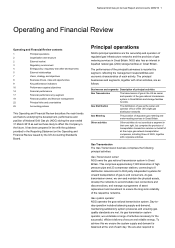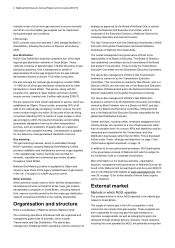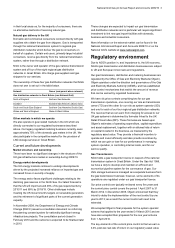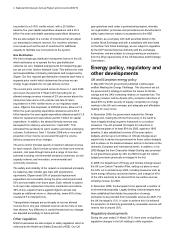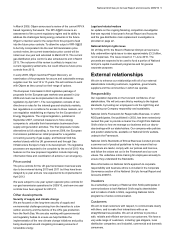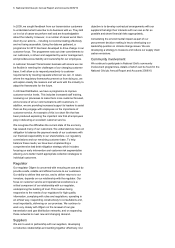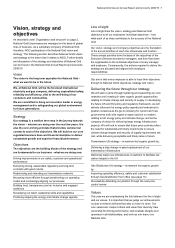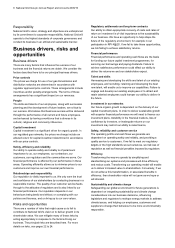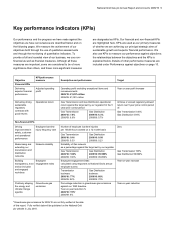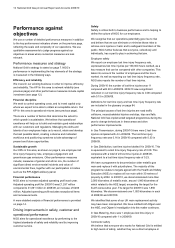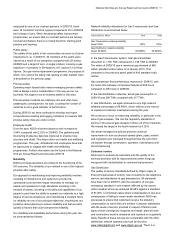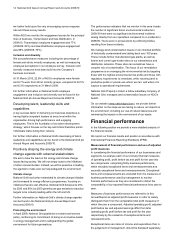National Grid 2010 Annual Report Download - page 6
Download and view the complete annual report
Please find page 6 of the 2010 National Grid annual report below. You can navigate through the pages in the report by either clicking on the pages listed below, or by using the keyword search tool below to find specific information within the annual report.4 National Grid Gas plc Annual Report and Accounts 2009/10
(equivalent to a 5.05% vanilla return), with a £0.9 billion
baseline five year capital expenditure allowance and a £0.3
billion five year controllable operating expenditure allowance.
We are also subject to a number of incentives that can adjust
our transmission network revenue. Our incentive schemes
cover areas such as the cost of investment for additional
capacity to facilitate new connections to the system.
Gas Distribution
We hold a single gas distribution transporter licence in the UK,
which authorises us to operate the four gas distribution
networks we own. Detailed arrangements for transporting gas
are set out in the Uniform Network Code. This defines the roles
and responsibilities of industry participants and is approved by
Ofgem. Our four regional gas distribution networks each have a
separate price control which determines the prices we can
charge to gas shippers for our gas delivery service.
The current price control period came into force on 1 April 2008
and covers the period to 31 March 2013 providing for an
allowed average revenue increase of 2% per annum above the
retail price index and a 4.3% post-tax real rate of return
(equivalent to 4.94% vanilla return) on our regulatory asset
value. Ofgem’s final proposals, at 2005/06 prices, allow a £1.6
billion five year operating expenditure allowance and a £2.5
billion baseline five year capital expenditure allowance split £1.8
billion for replacement expenditure and £0.7 billion for capital
expenditure. In addition, the allowed formula revenue was
decoupled from delivery volumes from 1 April 2007. This
eliminated the sensitivity to warm weather and lower underlying
volumes. Furthermore, from 1 October 2008 only a very small
proportion of our income is recovered through the volume
delivery component of our charges.
The price control formulas specify a maximum allowed revenue
for each network. Each formula consists of a fixed core revenue
element, cost pass-through items and a range of incentive
schemes including: environmental emissions incentives; an exit
capacity scheme; and innovation, environmental and
community incentives.
The safety and reliability of the network is maintained principally
by replacing older metallic gas main with polyethylene
equivalents. Ofgem treats 50% of projected replacement
expenditure as recoverable during the price control period and
50% as recoverable over future years. Each network is subject
to its own main replacement incentive mechanism and retains
36% of any outperformance against Ofgem’s annual cost
targets as additional return or, alternatively, bears 36% of any
overspend if it underperforms.
Transportation charges are set broadly to recover allowed
revenue but in any year collected revenue can be more or less
than allowed. Any difference is carried forward and our charges
are adjusted accordingly in future periods.
Other regulation
NGG’s businesses are also subject to safety legislation which is
enforced by the Health and Safety Executive (HSE). Our UK
gas operations work under a permissioning regime, whereby
our organisation, processes and procedures are documented in
safety cases that are subject to acceptance by the HSE.
In addition, as a company with debt securities listed on the
London Stock Exchange and with a subsidiary with debt listed
on the New York Stock Exchange, we are subject to regulation
by the UK Financial Services Authority and the exchanges
themselves, and are subject to rules governing an exemption
from the filing requirements of the US Securities and Exchange
Commission.
Energy policy, regulatory and
other developments
UK and European energy policy
In May 2007 the UK government published a white paper
entitled Meeting the Energy Challenge. This document set out
the government’s strategy to address the issues of climate
change and the UK’s increasing reliance on imported fuel. The
strategy includes: carbon dioxide (CO2) emission reductions of
about 60% by 2050; security of supply; competition in energy
markets in the UK and overseas; and adequate and affordable
heating for every home.
In November 2008, the government enacted the Climate
Change Act, making the UK the first country in the world to
have a legally binding long-term framework to cut carbon
emissions. The Act provided for targets for reductions in
greenhouse gases of at least 80% by 2050, against a 1990
baseline. It also established a series of five year carbon
budgets, and set up a Committee on Climate Change as an
expert body to advise the government on those carbon budgets
and to advise on the balance between actions to be taken at the
domestic, European and international levels. In addition, in his
2009 Budget the then Chancellor Alistair Darling also promised
to cut greenhouse gases by 34% by 2020 through the carbon
budget provisions previously envisaged in the Act.
In 2009, the Department of Energy and Climate Change issued
the UK Low Carbon Transition Plan, setting out plans to meet
the 34% cut in emissions by 2020, including measures such as
home energy efficiency and smart meters, and a target of 40%
of the UK’s electricity to be derived from low carbon sources,
including nuclear, by 2020.
In December 2008, the European Union approved a number of
environmental proposals. Legally binding national targets have
been established that dictate the proportion of energy
production to be provided from renewable sources by 2020. For
the UK the target is 15%. In order to achieve this it is believed
the proportion of electricity generated by renewable sources will
need to rise to around 35%.
Regulatory developments
During the year ended 31 March 2010, there were no significant
legislative changes in the UK relating to utility regulation.

